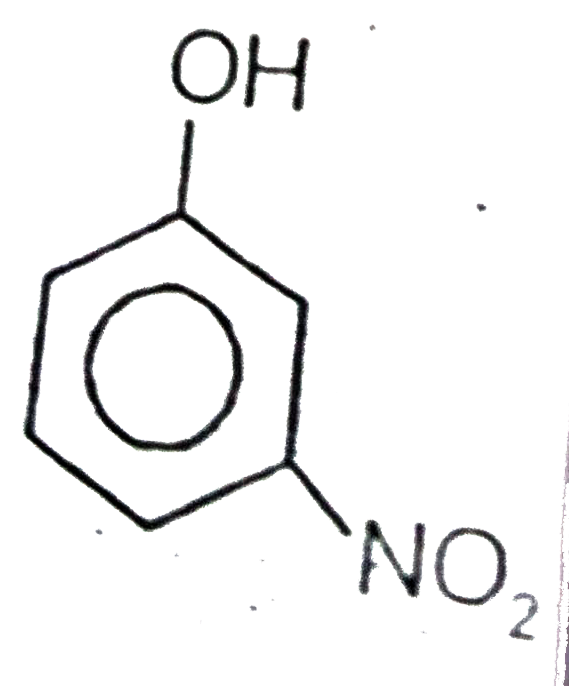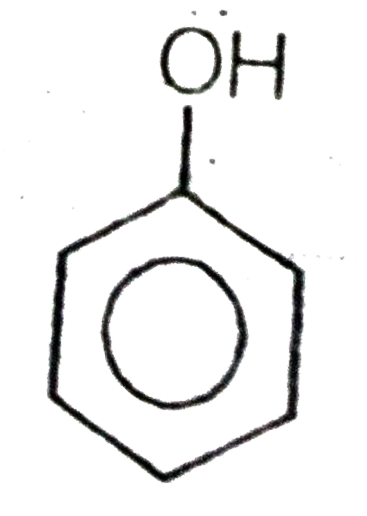Most acidic among the following is
(a) 
(b) 
(c) 
(d) 
The correct Answer is:D
To determine which compound is the most acidic among the given options, we need to analyze the stability of the conjugate bases formed after the removal of a proton (H⁺) from each compound. The acidity of a compound is influenced by the stability of its conjugate base; the more stable the conjugate base, the stronger the acid.
1. Identify the Compounds:
Let's denote the compounds as A, B, C, and D based on the options provided.
2. Analyze Compound A:
- When a proton is removed from compound A, a conjugate base is formed.
- The conjugate base has a negative charge that can be influenced by the presence of a nitro group (NO₂) at the meta position.
- The nitro group exhibits a -M (minus mesomeric) effect but only shows inductive effect at the meta position, which means it stabilizes the negative charge through inductive withdrawal of electron density.
- Thus, the conjugate base is somewhat stabilized, but not as much as it could be if the nitro group were at the ortho or para position.
3. Analyze Compound B:
- Similar to compound A, when a proton is removed from compound B, a conjugate base is formed.
- This compound also has a nitro group at the meta position, which again only shows inductive effect.
- However, the presence of a methyl group (which is +I, or inductively donating) means that the overall stabilization of the negative charge is less effective compared to compound A.
- Therefore, the conjugate base of compound B is less stable than that of compound A.
4. Analyze Compound C (Phenol):
- Upon removal of a proton from phenol, the conjugate base is formed.
- In this case, the negative charge can be delocalized over the entire aromatic ring through resonance.
- This resonance stabilization significantly enhances the stability of the conjugate base, making phenol more acidic than both compounds A and B.
5. Analyze Compound D:
- When a proton is removed from compound D, a conjugate base is formed.
- The negative charge can also be delocalized through resonance, and the presence of a nitro group at the para position provides a strong -M effect, which greatly stabilizes the negative charge.
- This means that the conjugate base formed from compound D is highly stable due to effective resonance and the strong electron-withdrawing nature of the nitro group.
6. Compare the Stability of Conjugate Bases:
- Compound A: Moderate stability due to inductive effect of NO₂.
- Compound B: Less stable than A due to the +I effect of the methyl group.
- Compound C (Phenol): More stable due to resonance.
- Compound D: Most stable due to strong resonance and -M effect of NO₂.
7. Conclusion:
- Based on the stability of the conjugate bases, compound D is the most acidic among the given options.
Final Answer:
The most acidic compound among the given options is Compound D.
Let's denote the compounds as A, B, C, and D based on the options provided.
- When a proton is removed from compound A, a conjugate base is formed.
- The conjugate base has a negative charge that can be influenced by the presence of a nitro group (NO₂) at the meta position.
- The nitro group exhibits a -M (minus mesomeric) effect but only shows inductive effect at the meta position, which means it stabilizes the negative charge through inductive withdrawal of electron density.
- Thus, the conjugate base is somewhat stabilized, but not as much as it could be if the nitro group were at the ortho or para position.
- Similar to compound A, when a proton is removed from compound B, a conjugate base is formed.
- This compound also has a nitro group at the meta position, which again only shows inductive effect.
- However, the presence of a methyl group (which is +I, or inductively donating) means that the overall stabilization of the negative charge is less effective compared to compound A.
- Therefore, the conjugate base of compound B is less stable than that of compound A.
- Upon removal of a proton from phenol, the conjugate base is formed.
- In this case, the negative charge can be delocalized over the entire aromatic ring through resonance.
- This resonance stabilization significantly enhances the stability of the conjugate base, making phenol more acidic than both compounds A and B.
- When a proton is removed from compound D, a conjugate base is formed.
- The negative charge can also be delocalized through resonance, and the presence of a nitro group at the para position provides a strong -M effect, which greatly stabilizes the negative charge.
- This means that the conjugate base formed from compound D is highly stable due to effective resonance and the strong electron-withdrawing nature of the nitro group.
- Compound A: Moderate stability due to inductive effect of NO₂.
- Compound B: Less stable than A due to the +I effect of the methyl group.
- Compound C (Phenol): More stable due to resonance.
- Compound D: Most stable due to strong resonance and -M effect of NO₂.
- Based on the stability of the conjugate bases, compound D is the most acidic among the given options.
The most acidic compound among the given options is Compound D.
Similar Questions
Knowledge Check
Weakest acid among the following is
Aacetic acidBphenolCwaterDacetyleneWeakest acid among the following is
Aacetic acidBphenolCwaterDacetyleneWeakest acid among the following is
Aacetic acidBphenolCwaterDacetylene